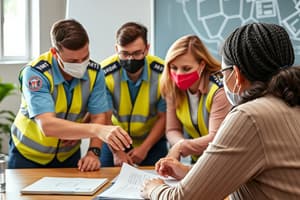Podcast
Questions and Answers
All behavior is a form of communication.
All behavior is a form of communication.
True (A)
The Directive Staff approach is a response to which Crisis Development Model behavior level?
The Directive Staff approach is a response to which Crisis Development Model behavior level?
Defensive
When a person is in tension reduction, what is an appropriate response?
When a person is in tension reduction, what is an appropriate response?
Re-establish the relationship
Which statement best describes rational detachment?
Which statement best describes rational detachment?
Precipitation factors are underlying reasons for behavior.
Precipitation factors are underlying reasons for behavior.
You can influence the crisis by controlling another person's attitude.
You can influence the crisis by controlling another person's attitude.
What is something to keep in mind when listening with empathy?
What is something to keep in mind when listening with empathy?
The Supportive Stance is managing your position, posture, and proximity in relation to the person in crisis.
The Supportive Stance is managing your position, posture, and proximity in relation to the person in crisis.
Nonverbal communication includes which of the following?
Nonverbal communication includes which of the following?
When a person asks a question you perceive as challenging (such as 'Who do you think you are?'), the recommended response would be to ____.
When a person asks a question you perceive as challenging (such as 'Who do you think you are?'), the recommended response would be to ____.
Important points for limit settings are:
Important points for limit settings are:
The verbal escalation continuum is an expansion of which behavior level of the Crisis Development Model?
The verbal escalation continuum is an expansion of which behavior level of the Crisis Development Model?
Removing potential hazards in your environment can improve safety.
Removing potential hazards in your environment can improve safety.
When you notice your coworker in a situation that continues to escalate, what should you do?
When you notice your coworker in a situation that continues to escalate, what should you do?
The physical skills review framework allows you to reflect on the suitability of each restrictive intervention to maximize safety and minimize ______.
The physical skills review framework allows you to reflect on the suitability of each restrictive intervention to maximize safety and minimize ______.
Restrictive interventions should always be considered as a last resort.
Restrictive interventions should always be considered as a last resort.
The Decision Making Matrix assesses risks based on likelihood and _____
The Decision Making Matrix assesses risks based on likelihood and _____
During the control phase of the COPING Model you want to _______________.
During the control phase of the COPING Model you want to _______________.
How can you support staff after a crisis?
How can you support staff after a crisis?
The COPING Model helps your organization support staff and the people in your care with a restorative approach.
The COPING Model helps your organization support staff and the people in your care with a restorative approach.
What is the goal when de-escalating crisis behavior?
What is the goal when de-escalating crisis behavior?
Once someone reaches tension reduction, no further action is needed.
Once someone reaches tension reduction, no further action is needed.
Flashcards
Behavior Communication
Behavior Communication
All behavior is a form of communication, expressing underlying needs or messages.
Crisis Development Model (Directive Staff)
Crisis Development Model (Directive Staff)
The Directive Staff approach works best with individuals needing direction and support (Defensive behavior level).
Tension Reduction
Tension Reduction
Rebuilding relationships is key for healing and rapport during tension reduction.
Rational Detachment
Rational Detachment
Signup and view all the flashcards
Precipitation Factors
Precipitation Factors
Signup and view all the flashcards
Influence on Crisis (Control)
Influence on Crisis (Control)
Signup and view all the flashcards
Empathetic Listening
Empathetic Listening
Signup and view all the flashcards
Supportive Stance
Supportive Stance
Signup and view all the flashcards
Nonverbal Communication
Nonverbal Communication
Signup and view all the flashcards
Responding to Challenges
Responding to Challenges
Signup and view all the flashcards
Limit Setting
Limit Setting
Signup and view all the flashcards
Verbal Escalation Continuum
Verbal Escalation Continuum
Signup and view all the flashcards
Safety Improvement
Safety Improvement
Signup and view all the flashcards
Collaborative Approaches
Collaborative Approaches
Signup and view all the flashcards
Restrictive Interventions
Restrictive Interventions
Signup and view all the flashcards
Decision Making Matrix
Decision Making Matrix
Signup and view all the flashcards
Control Phase (COPING Model)
Control Phase (COPING Model)
Signup and view all the flashcards
Staff Support (Post-Crisis)
Staff Support (Post-Crisis)
Signup and view all the flashcards
COPING Model
COPING Model
Signup and view all the flashcards
De-escalation Goal
De-escalation Goal
Signup and view all the flashcards
Post-Tension Reduction Actions
Post-Tension Reduction Actions
Signup and view all the flashcards
Study Notes
Behavior Communication
- All behavior serves as a form of communication, indicating underlying messages or needs.
Crisis Development Model
- The Directive Staff approach is applicable in the Defensive behavior level, characterized by a need for direction and support.
Tension Reduction
- Re-establishing relationships is essential when an individual is in a tension reduction phase to promote healing and rapport.
Rational Detachment
- Maintaining rational detachment involves managing personal behavior and attitudes professionally, especially in challenging situations.
Precipitation Factors
- Precipitation factors refer to underlying reasons for behavior, highlighting motivations that lead to escalated actions.
Influence on Crisis
- Controlling another person's attitude does not effectively influence the course of a crisis.
Empathetic Listening
- When listening with empathy, giving undivided attention to the speaker is crucial for understanding and validation.
Supportive Stance
- The Supportive Stance involves managing your posture, position, and proximity to facilitate a calming presence for those in crisis.
Nonverbal Communication
- Body language is a key component of nonverbal communication, significantly impacting interpersonal interactions.
Responding to Challenges
- When faced with challenging questions, it is advised to downplay the challenge rather than escalate conflict.
Limit Setting
- Effective limit setting should be respectful, straightforward, and reasonable to promote understanding and compliance.
Verbal Escalation Continuum
- The verbal escalation continuum expands on the Defensive behavior level, guiding responses to escalating verbal conflicts.
Safety Improvement
- Removing potential hazards from the environment is crucial for enhancing safety and preventing crises.
Collaborative Approaches
- In escalating situations, utilizing a coordinated and collaborative approach is best practice for intervention.
Physical Skills Review
- The physical skills review framework assesses restrictive interventions to maximize safety and minimize harm to individuals involved.
Restrictive Interventions
- Restrictive interventions should always be viewed as a last resort, ensuring other de-escalation techniques are prioritized.
Decision Making Matrix
- The Decision Making Matrix evaluates risks based on likelihood and severity to inform appropriate responses.
Control Phase of COPING Model
- During the control phase of the COPING Model, ensuring that all parties have returned to a calm state is critical for resolution.
Staff Support Post-Crisis
- Supporting staff after a crisis can include inviting them to discuss the incident to process experiences and feelings.
COPING Model
- The COPING Model is conducive to supporting staff and individuals in care, employing a restorative approach after crises.
De-escalation Goal
- The primary goal when de-escalating crisis behavior is to achieve tension reduction, alleviating distress for individuals involved.
Post-Tension Reduction Actions
- After reaching tension reduction, further actions are still required to ensure long-term safety and emotional recovery.
Studying That Suits You
Use AI to generate personalized quizzes and flashcards to suit your learning preferences.




